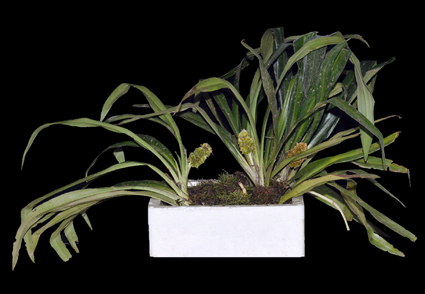Abstract
Rohdea grandiflora, a new species from Gansu, China, is described and illustrated. It is most similar to R. pachynema in sharing a long slender subterranean stolon, but differs mainly by the longer inner bracts, larger flowers, and columnar filaments adnate to the middle or basal portion of perianth lobes and not connate to adjacent ones.
References
APG IV. (2016) An update of the Angiosperm Phylogeny Group classification for the orders and families of flowering plants: APG IV. Botanical Journal of the Linnean Society 181: 1–20. https://doi.org/10.1111/boj.12385
Baillon, H. (1893) Les plantes alliées aux Tupistra (suite). Bulletin Mensuel de la Société Linnéenne de Paris 2: 1113–1117.
Deng, Y.F. (2017) Rohdea fargesii, the correct name for Rohdea chinensis (Asparagaceae). Phytotaxa 302 (3): 298–299. https://doi.org/10.11646/phytotaxa.302.3.12
Deng, Y.F. (2019) A new combination in Rohdea (Asparagaceae). Phytotaxa 411 (2): 127–128. https://doi.org/10.11646/phytotaxa.411.2.7
Raunkiaer, C. (1934) Plant life forms. Oxford University Press, Oxford. 104 pp.
Roth, A.W. (1821) Novae plantarum species praesertim Indiae orientalis: Ex collectione doct. Benj. Heynii: cum descriptionibus et observationibus. Sumptibus H. Vogler, Halberstadii. 412 pp. https://doi.org/10.5962/bhl.title.10723
Tanaka, N. (2003) New combinations in Rohdea (Convallariaceae). Novon 13: 329–333. https://doi.org/10.2307/3393269
Tanaka, N. (2010) A taxonomic revision of the genus Rohdea (Asparagaceae). Makinoa New Series 9: 1–54.
Tanaka, N. (2019) Rohdea henryi, the replacement name for R. chinensis, and a new combination for its variety (Asparagaceae). Phytotaxa 400: 48–50.
Wang, F.T. & Tang, T. (1949) Notes on Chinese Liliaceae VIII. Contributions from the Institute of Botany 6: 105–114.
Baillon, H. (1893) Les plantes alliées aux Tupistra (suite). Bulletin Mensuel de la Société Linnéenne de Paris 2: 1113–1117.
Deng, Y.F. (2017) Rohdea fargesii, the correct name for Rohdea chinensis (Asparagaceae). Phytotaxa 302 (3): 298–299. https://doi.org/10.11646/phytotaxa.302.3.12
Deng, Y.F. (2019) A new combination in Rohdea (Asparagaceae). Phytotaxa 411 (2): 127–128. https://doi.org/10.11646/phytotaxa.411.2.7
Raunkiaer, C. (1934) Plant life forms. Oxford University Press, Oxford. 104 pp.
Roth, A.W. (1821) Novae plantarum species praesertim Indiae orientalis: Ex collectione doct. Benj. Heynii: cum descriptionibus et observationibus. Sumptibus H. Vogler, Halberstadii. 412 pp. https://doi.org/10.5962/bhl.title.10723
Tanaka, N. (2003) New combinations in Rohdea (Convallariaceae). Novon 13: 329–333. https://doi.org/10.2307/3393269
Tanaka, N. (2010) A taxonomic revision of the genus Rohdea (Asparagaceae). Makinoa New Series 9: 1–54.
Tanaka, N. (2019) Rohdea henryi, the replacement name for R. chinensis, and a new combination for its variety (Asparagaceae). Phytotaxa 400: 48–50.
Wang, F.T. & Tang, T. (1949) Notes on Chinese Liliaceae VIII. Contributions from the Institute of Botany 6: 105–114.


